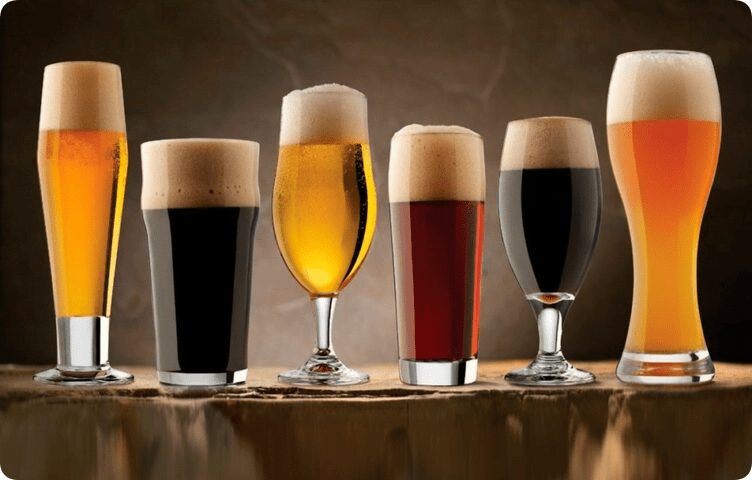Gone are the days when visitors to beer bars received their orders in plastic glasses. Nowadays, in good establishments there are as many varieties of glasses as there are varieties of product. Is presentation really that important? The simple answer is yes! If you want to fully enjoy your favorite drink, learn more about the types of beer glassware .
A little about beer and glasses
True connoisseurs never drink from a bottle or can. A spicy aroma, a lush head of foam, gas bubbles playing in the liquid - these are the details that make up the pleasure of drinking beer. Its properties are maximized by specially shaped dishes - tall glass glasses . In them, carbon dioxide rises faster to the top. This eliminates the unpleasant feeling of bloating and belching after drinking the drink.
Thanks to a glass glass, you can evaluate the main properties of beer:
- appearance - color, transparency, presence of sediment are best perceived through glass;
- foam - tall dishes ensure the correct formation and stability of the foam cap;
- aroma - in a narrow vessel, the odors of hops or malt spread faster, enhancing the perception of taste.
Properly selected tableware not only emphasizes the flavor profile of the product, but also increases the aesthetic pleasure of its consumption.
Main distinctive features

Each type of beer has a specific type of glass with a clear silhouette that affects the appearance, aroma and even the speed with which it is customary to drink the product.
There are six features of a beer glass:
large size - traditionally 2-3 times larger than that of wine vessels. The volume depends on the alcohol content - the higher it is, the smaller the dishes;
a thin edge is the most important part of a beer product, ensuring smooth distribution of aroma and ease of drinking;
wide rim - upward expansion of the vessel helps concentrate foam and odor;
concave bowl - narrowing in the middle part of the product improves the distribution of gas bubbles and also provides a comfortable grip;
bulb - this is the name given to the thickening in the upper part of the vessel. It helps distribute the aroma and is usually used in glasses for varieties with a high amount of foam;
massive base - necessary for stability. Allows you to hold dishes without heating the contents with your hand.
In addition to the six general features, there are many additional details - legs of different heights, bends, handles .
Types of beer glasses
Even an ignorant person knows that beer is served in a glass, mug or pint . Specialists know more than 100 types of glassware for this product. The size and style of each vessel are designed taking into account the characteristics of the variety or the situation in which the drink is consumed.
By shape

The most common silhouettes of a beer glass are a cylinder and a cone; less commonly, a round vessel resembling a wine glass is used. Popular tableware models have been created based on these shapes, including:
- pint (nonik) - a product in the form of an inverted cone with a thickening on top. The wide neck makes drinking easier and promotes the formation of thick foam. The pint is ideal for a highly carbonated and not very chilled drink;
- stange (tube) - a tall, narrow cylindrical vessel with straight walls. Maintains persistent foam, favorably emphasizes the aromas of malt and hops;
- Pilsner - developed specifically for the product of the same name. It is a tall conical glass with a volume of 0.33 l. Ideally demonstrates the play of gas bubbles and the golden hue of Pils, holds the foam for a long time;
- Weizen is a vessel with a volume of 250 to 500 ml, narrow at the base and slightly widening at the top. Quickly reveals the smell, controls the volume of foam;
- tulip - a tall glass with smoothly curved walls, reminiscent of a flower cup. Gradually releases the aroma and promotes the formation of a dense foam cap. Serves for serving strong drinks;
- snifter is a traditional glassware for brandy, also used for strong beer. It features a voluminous round bowl and a low leg. The tapered neck concentrates flavors and emphasizes the thickness of the foam;
- flute - usually in such narrow glasses with a high knifewhere they serve champagne. Also suitable for highly carbonated and fruity beers. The narrow bowl prevents the release of carbon dioxide, resulting in a beautiful play of bubbles. The long stem prevents the drink from heating up by hand;
- shalis - a vessel with a wide round bowl on a long stem. Collects a slowly settling foam cap up to 2 cm thick on the surface;
- A mug is a product made of thick glass with a handle. Often complemented by notches on the sides. Holds from 500 ml to 1 liter of liquid.
The foamy drink can also be served in wine glasses with a volume of 500 ml or more.
Based on materials
The container for serving beer should be smooth, transparent, with thin walls . Therefore, glass, crystal or plastic are used for production. Glass equipment is most often found in bars. It is durable, easy to clean and improves the properties of the drink. The most profitable option for catering establishments is tempered glass, the strength of which is 5 times higher than regular glass. This material can withstand sudden temperature fluctuations, so glasses can be removed from the dishwasher and immediately put in the refrigerator.
Another advantage of tempered glass is impact safety. It breaks down into small, non-sharp particles, which reduces the likelihood of injury.
In restaurants and at home feasts, beer is often served in crystal glasses . Crystal refracts light beautifully, giving contents a more sophisticated look than regular glass. Such dishes are often decorated with carvings and color painting. But crystal products are not durable enough, so they have to be washed by hand.
Plastic or acrylic glasses are used in inexpensive establishments, as well as during outdoor events where the safety of utensils is not important.
Less popular materials for making beer glassware are ceramics, stainless steel, copper .
Mugs are traditionally made from ceramics . They are durable, elegant, and keep the drink cold for a long time. The disadvantages of ceramic utensils are their heavy weight and the need for hand washing.
Stainless steel is durable, withstands temperature changes well, and attracts attention with a beautiful shine. But the opaque walls do not allow one to see the appearance of the product. Typically, steel glasses are used during outdoor feasts.
Copper is used to make gift mugs. They are distinguished by their elegant design and durability, and retain the temperature of the drink well. But copper utensils are difficult to care for - they must be washed only by hand and periodically cleaned with special products.
By purpose

Glasses of one shape or another are chosen for serving not only for aesthetic reasons. Each product corresponds to the qualities of certain types of beer, for example:
- porter, stout, British ale - classic pint;
- Scotch ale - glass mug;
- lambic, gueuze, rye beer - glass-pipe;
- Weizenbock, Crystal Weizen, wheat ale - Weizen;
- imperial stout, Belgian strong ale - tulip;
- barley wine, India pale ale, bière de garde, imperial stout - snifter;
- pilsner, American light beer, light ale - pilsner;
- lambic, bierre brut, red ale - flute.
For inexpensive supermarket drinks, a simple pint glass will do.
Craft products are served in dishes prescribed by bar traditions.
How to choose glasses based on the type of beer
There is a simplified method for choosing beer utensils - based on the color of the drink. Tulip is recommended for any lager. Its narrow bowl allows bubbles to form, and the tapered neck promotes the appearance of a foamy head. White beer looks perfect in a tube glass. Amber varieties are served in a traditional pint. This shape of the glass allows you to clearly see the beautiful shade of the drink and helps create a beautiful foam.
For dark beer, a large snifter is suitable. Its narrowed neck allows for maximum collection of aromas inside. Since dark varieties have little carbon dioxide, a wide bowl is not required. Flavored versions of the product are served in a chalice glass, the wide bowl of which evenly distributes the aroma.
Review of beautiful beer glasses
Let us present three elegant glass products from renowned manufacturers.
The first model is a pint from an Italian companyli-rocco/">Bormioli Rocco. Behind the laconic classic silhouette lies increased strength - the glasses are made of impact-resistant soda-lime glass. They are dishwasher compatible, easily stackable, and fit comfortably in the hand.
The second leader in the rating is the snifter from Rastal Teku. The high foot prevents the bowl from heating up by hand. The narrowed neck retains the aromas inside the glass. The material for the snifter is tempered glass, so it can be washed in the dishwasher.
Another example of a beer classic is the Craftbrew pilsner produced by the French company Luminarc. The massive bottom provides stability, and the high, flaring bowl helps to reveal the spicy aromas of ale and light beer. Thanks to its elegant shape, the glass is also suitable for serving lemonade, juices, and cocktails.
Care and storage of beer glasses
Insufficiently clean dishes impair the appearance and taste of the drink. The absence of visible stains and drips does not mean that the product is absolutely clean. If gas bubbles stick to the walls, it means that the glass is coated on the inside with tiny particles of grease and dirt.
A five-step algorithm will help you wash your glasses correctly:
- Wipe the items inside and out with a clean sponge, removing any noticeable stains.
- Fill with hot water and leave to soak for a while.
- Wipe the glass with a mixture of three parts baking soda, one part salt and a little water.
- Then remove any remaining mixture with a clean cloth.
- Rinse the glasses clean with hot running water.
- Leave the dishes to dry on the counter or drying rack.
In bars, glasses are usually stored on drain boards, drying racks or hanging racks. At home, glass utensils can be stacked and put away in a cupboard or placed on a special holder.
















































/https%3A%2F%2Fcomplexbar.com%2Fimages%2Fblog%2F58%2Fpivnye-bokaly.jpg)
/https%3A%2F%2Fcomplexbar.com%2Fimages%2Fblog%2F245%2Fskov_glavn.jpeg)
/https%3A%2F%2Fcomplexbar.com%2Fimages%2Fblog%2F245%2Fhaiboli.jpg)
/https%3A%2F%2Fcomplexbar.com%2Fimages%2Fblog%2F245%2Fvilki-na-stole-752x480.jpeg)
/https%3A%2F%2Fcomplexbar.com%2Fimages%2Fblog%2F246%2F2024-04-09_17.22.54.jpg)
/https%3A%2F%2Fcomplexbar.com%2Fimages%2Fblog%2F246%2F2024-04-09_17.22.47.jpg)
/https%3A%2F%2Fcomplexbar.com%2Fimages%2Fblog%2F246%2FCODE_anons_foamydrops_752%D1%85480_eng.jpg)
/https%3A%2F%2Fcomplexbar.com%2Fimages%2Fblog%2F246%2FAlina_752%D1%85480_eng.jpg)
/https%3A%2F%2Fcomplexbar.com%2Fimages%2Fblog%2F246%2F2024-04-09_17.23.22.jpg)
/https%3A%2F%2Fcomplexbar.com%2Fimages%2Fblog%2F246%2F2024-04-09_17.23.28.jpg)
/https%3A%2F%2Fcomplexbar.com%2Fimages%2Fblog%2F246%2F2024-04-09_17.23.35.jpg)
/https%3A%2F%2Fcomplexbar.com%2Fimages%2Fblog%2F246%2Fdrinksome_752%D1%85480_eng.jpg)
/https%3A%2F%2Fcomplexbar.com%2Fimages%2Fblog%2F246%2Fnude_752%D1%85480_eng.jpg)
/https%3A%2F%2Fcomplexbar.com%2Fimages%2Fblog%2F246%2F752%D1%85480_eng__1_.jpg)
/https%3A%2F%2Fcomplexbar.com%2Fimages%2Fblog%2F246%2F752%D1%85480_eng.jpg)
/https%3A%2F%2Fcomplexbar.com%2Fimages%2Fblog%2F246%2FStudioRaw_752%D1%85480_eng.jpg)
/https%3A%2F%2Fcomplexbar.com%2Fimages%2Fblog%2F246%2FDoppio_tea_752%D1%85480_eng.jpg)
/https%3A%2F%2Fcomplexbar.com%2Fimages%2Fblog%2F246%2FTognana_Stars_Stripes_752%D1%85480_eng.jpg)
/https%3A%2F%2Fcomplexbar.com%2Fimages%2Fblog%2F246%2FRona_752%D1%85480_eng.jpg)
/https%3A%2F%2Fcomplexbar.com%2Fimages%2Fblog%2F246%2FDoppio_vending_752%D1%85480_eng.jpg)
/https%3A%2F%2Fcomplexbar.com%2Fimages%2Fblog%2F246%2FEssence_sukhie_smesi_752%D1%85480_eng.jpg)
/https%3A%2F%2Fcomplexbar.com%2Fimages%2Fblog%2F246%2FODK_sukhie_smesi752%D1%85480_eng.jpg)
/https%3A%2F%2Fcomplexbar.com%2Fimages%2Fblog%2F246%2Funiforma-barmena.jpg)
/https%3A%2F%2Fcomplexbar.com%2Fimages%2Fblog%2F246%2Fkak-nanyat-barmena.jpg)
/https%3A%2F%2Fcomplexbar.com%2Fimages%2Fblog%2F246%2Fsirop_scale_2400.jpeg)
/https%3A%2F%2Fcomplexbar.com%2Fimages%2Fblog%2F246%2FPeugeot_Anons_Paris_U%27Select_Line_Daman_752%D1%85480_eng.jpg)
/https%3A%2F%2Fcomplexbar.com%2Fimages%2Fblog%2F246%2Fkofe-vostochniy.jpg)
/https%3A%2F%2Fcomplexbar.com%2Fimages%2Fblog%2F246%2FMadler.jpg)
/https%3A%2F%2Fcomplexbar.com%2Fimages%2Fblog%2F246%2Fprofbartender_glavn.jpeg)